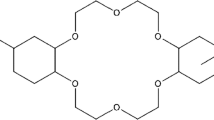Abstract
Newton and Bevis1 concentrated some animal viruses by adding zinc hydroxide to the virus suspension and afterwards dissolving the gel in saturated ethylenediamine tetraacetic acid solution in order to recover the virus. Attempts made in our laboratory to concentrate poliovirus by this method yielded unsatisfactory results.
Similar content being viewed by others
References
Newton, N., and Bevis, R., Virology, 8, 344 (1959).
Grossowicz, N., Mercado, A., and Goldblum, N., Proc. Soc. Exp. Biol. and Med., 103, 872 (1960).
Le Bouvier, G., Brit. J. Exp. Pathol., 40, 452 (1959).
Author information
Authors and Affiliations
Rights and permissions
About this article
Cite this article
HORODNICEANU, F., SERGIESCU, D., KLEIN, R. et al. Concentration and Partial Purification of Poliovirus by means of Zinc Hydroxide and Ion-exchanging Resin. Nature 193, 600–601 (1962). https://doi.org/10.1038/193600b0
Issue Date:
DOI: https://doi.org/10.1038/193600b0
- Springer Nature Limited





